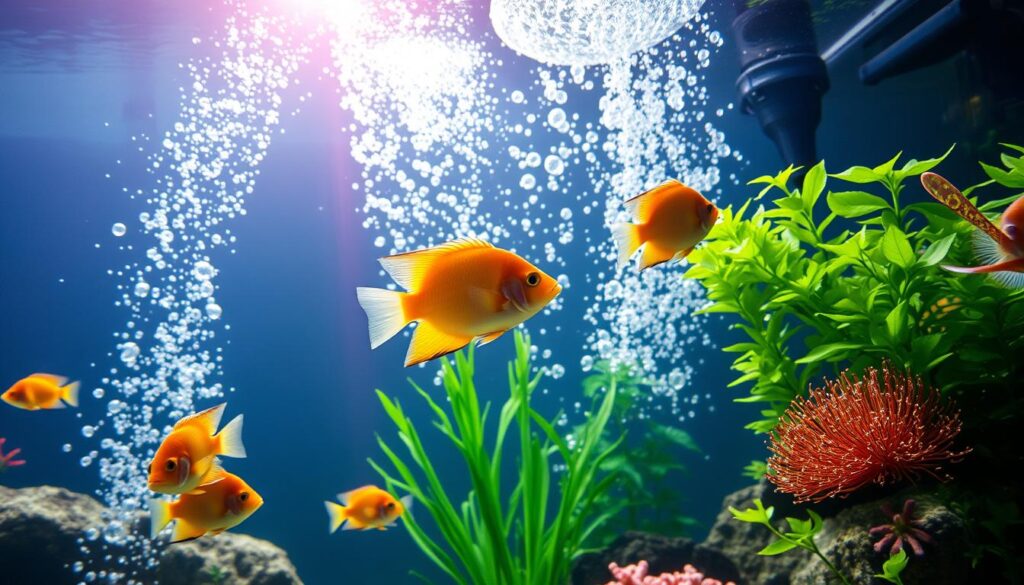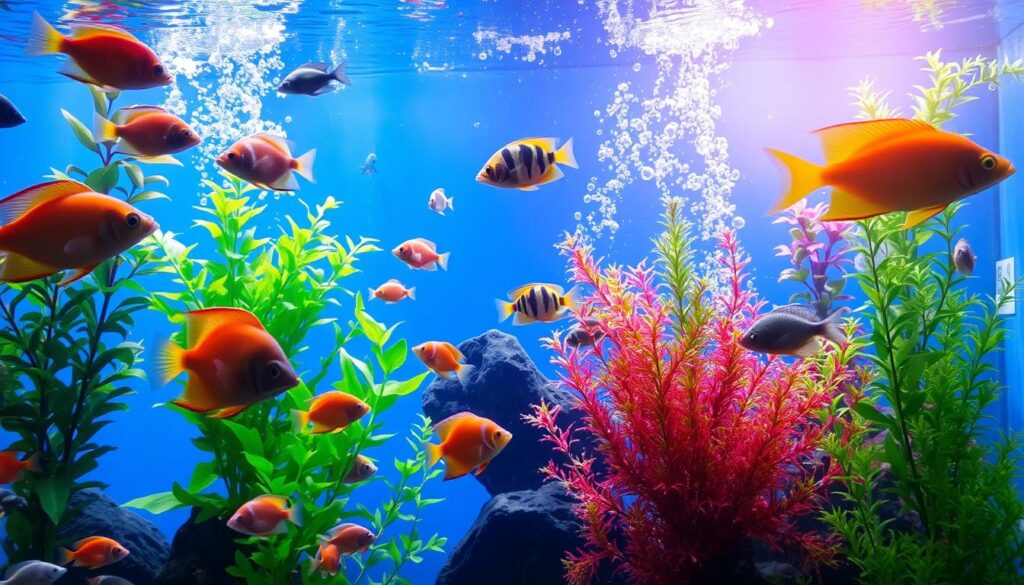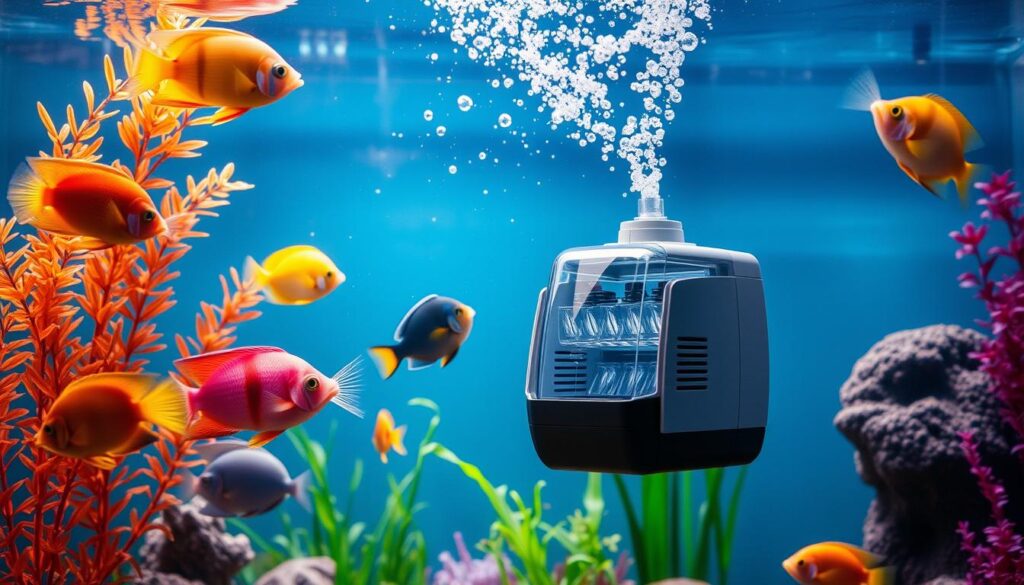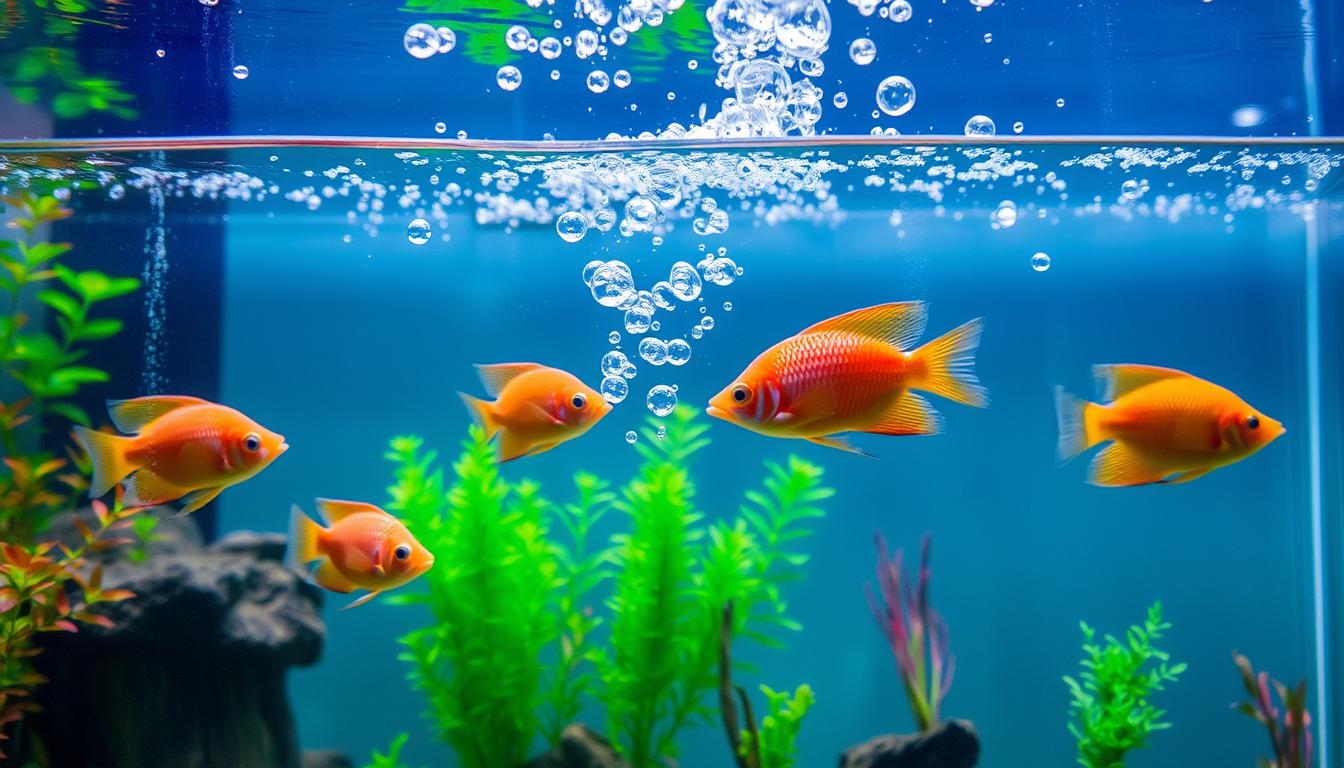Keeping the right oxygen levels in fish tanks is vital for their health. It ensures a happy home for our aquatic friends. Knowing how important oxygen is helps us create a better environment for them.
Having the right oxygen levels is key for our fish’s happiness. Many things can change these levels, like water temperature and quality. It’s important to keep these levels right for our fish’s health.
Introduction to Aquarium Oxygenation
Having the right oxygen in aquariums is crucial for our fish’s health. We can keep the oxygen levels up with air pumps and regular water changes. It’s important to understand the role of oxygen in aquariums for a healthy environment.
Key Takeaways
- Maintaining optimal fish tank oxygen levels is crucial for the health and well-being of aquatic pets.
- Optimal aquarium oxygen levels ensure a thriving environment for fish.
- Understanding the importance of oxygen in fish tanks is key to creating a healthy environment.
- Aquarium oxygen levels can be affected by various factors, including water temperature and quality.
- Ensuring optimal oxygen levels in fish tanks is vital for the health and well-being of fish.
- Optimal aquarium oxygen levels can be maintained through various methods, including the use of air pumps and water changes.
Understanding Fish Tank Oxygen Levels and Their Importance
Oxygen is key for fish health in an aquarium. Knowing how to boost oxygen in fish tanks is vital. Fish need oxygen to breathe, and without enough, they can get stressed, sick, or even die.
The best oxygen level for most freshwater tanks is 5-7 ppm. But, this can change based on the fish type and other factors. Healthy fish swim well, eat well, and live in clear water.
How Oxygen Affects Fish Health
Oxygen is crucial for fish metabolism. It helps break down food, move nutrients, and remove waste. Without enough oxygen, fish can get tired, stop eating, and get sick.
Optimal Oxygen Saturation Ranges
Every fish type needs a different oxygen level. Some need more than others. Knowing your fish’s oxygen needs is important for their health.
Signs of Proper Oxygenation
Healthy fish swim and eat well, and the water is clear. You can check oxygen levels with a water test kit. By knowing how to increase oxygen and keeping the tank aerated, you can make a great home for your fish.
Essential Equipment for Monitoring Aquarium Oxygen
To keep your oxygenation in aquarium right, you need the right tools. This includes oxygen test kits for accurate readings. Also, air pumps and aerators are key to boost oxygen by mixing water and air.
For maintaining fish tank oxygen, you have many options. Some important ones are:
- Oxygen test kits
- Air pumps
- Aerators
These tools help you keep oxygen levels just right. This makes a healthy space for your fish to grow.
Choosing the right gear is crucial for your fish’s health. Quality equipment and regular care ensure your tank has enough oxygenation in aquarium. This way, your fish get the oxygen they need to live.
Keeping an eye on your tank’s oxygen is key to avoiding issues. Knowing how to maintaining fish tank oxygen and using the right tools makes a big difference. It helps your fish thrive in their home.
Common Signs of Low Oxygen in Your Fish Tank
It’s important to know the signs of low oxygen in your fish tank. This helps you take action quickly to keep the oxygen levels right. Look out for signs like fish acting slow, breathing hard, or swimming weirdly. These can mean the oxygen is too low.
Some key signs to look out for include:
- Fish swimming near the surface of the water, gasping for air
- Labored breathing or rapid gill movement
- Erratic swimming patterns or lethargy
Also, watch for cloudy or discolored water. Sudden changes in the tank’s temperature can lower oxygen levels too. By spotting these signs and improving oxygen, you keep your fish healthy.

Keeping the right oxygen levels is key for your fish’s health. Spotting low oxygen signs and acting on them helps your tank thrive. Regular checks and upkeep stop oxygen problems, keeping your fish happy and healthy.
How Water Temperature Affects Oxygen Saturation
Water temperature is key to keeping fish tank oxygen levels right. Colder water can hold more oxygen than warm water. This is why aquarium oxygen levels are often higher in cooler temperatures. Yet, most tropical fish do better in warmer waters, making oxygen level management crucial.
To keep water temperature and oxygen levels balanced, consider these factors:
- Water temperature: Colder water can hold more oxygen, but most tropical fish prefer warmer temperatures.
- Fish species: Different fish species have varying oxygen requirements.
- Aquarium size: Larger aquariums may require more oxygen than smaller ones.
Keeping fish tank oxygen levels optimal is vital for your fish’s health. By understanding how water temperature impacts oxygen, you can ensure your aquarium oxygen levels stay healthy.
The Role of Air Pumps in Maintaining Fish Tank Oxygen Levels
An air pump for fish tanks is crucial for keeping the water oxygen-rich. It adds air to the water, boosting oxygen levels and removing carbon dioxide. It’s important to place and maintain air pumps correctly for them to work well.
There are many air pumps to choose from, each for different aquarium types. Understanding the different types of air pumps helps owners pick the right one. This ensures their tank stays healthy.
Types of Air Pumps
- Standard air pumps: suitable for most aquariums
- Saltwater air pumps: designed for saltwater tanks
- Submersible air pumps: can be placed underwater
Where you put the air pump matters a lot. It should be in a dry, well-ventilated spot, away from sunlight. Keeping the pump clean and replacing old parts is also key to its performance.
Choosing the right air pump and taking care of it properly helps keep your tank healthy. This creates a great home for your fish to live in.
Natural Methods to Increase Aquarium Oxygenation
Many aquarium owners wonder how to increase oxygen in fish tank. They often turn to air pumps. But, there are natural ways to boost oxygen levels too. Live plants are a great option because they make oxygen through photosynthesis.
Some plants, like anacharis and hornwort, are better at making oxygen. Good water flow is also key for healthy oxygen levels. Make sure water moves well and there’s nothing blocking it.
Don’t overstock your tank to avoid oxygen problems. These natural steps help keep your fish healthy. They also cut down on the need for air pumps, which are used for fish tank aeration.
- Adding a water fountain or waterfall to increase surface agitation
- Using a sponge filter to increase oxygenation
- Creating a balanced ecosystem with a variety of plants and animals
By using these natural methods, owners can make their aquariums a great place for fish to thrive.
Understanding Surface Agitation and Its Benefits
Surface agitation is key to keeping fish tanks oxygenated. It breaks the water’s surface tension, making gas exchange better. This is vital for keeping fish healthy.
For fish tank oxygen, surface agitation is crucial. Filters and air stones can create this movement. But, too much can harm fish.
Different Types of Surface Movement
- Filters: Create surface movement and agitation, helping to break the water’s surface tension.
- Air stones: Release bubbles, creating surface movement and agitation.
To keep fish tanks healthy, finding the right agitation is important. Watch how fish act and check water levels. The right amount of agitation keeps fish thriving.
The Impact of Plant Life on Oxygen Production
Plant life is key to keeping fish tank oxygen levels and aquarium oxygen levels right. Knowing which plants make the most oxygen helps aquarium owners. This knowledge lets them create a healthy environment for their fish.
Choosing the right plants is important. Hornwort, anacharis, and cabomba are top choices. They make lots of oxygen and do well in different aquarium settings.
Best Oxygen-Producing Aquatic Plants
- Hornwort: Easy to care for and highly efficient in oxygen production.
- Anacharis: Fast-growing and excellent for controlling algae while producing oxygen.
- Cabomba: A versatile plant that can be used in both foreground and background, known for its high oxygen output.
Day vs. Night Oxygen Cycles
Understanding day and night oxygen cycles is crucial. Plants make oxygen during the day but use it at night. This cycle helps keep fish tank oxygen levels stable for fish health.
Plant Density Considerations
Plant density affects oxygen production. It’s important to find a balance to avoid overplanting. This way, aquarium owners can support both plants and fish, keeping aquarium oxygen levels optimal.
How Stocking Density Affects Oxygen Requirements
Stocking density is key to keeping oxygen levels healthy in an aquarium. The number of fish compared to the tank’s size greatly impacts oxygen needs. Too many fish can lower oxygen levels because they use more oxygen. It’s important to figure out the right number of fish for your tank.
To find the right stocking density, think about the fish size and type, and the tank’s size. A common rule is to have 1-2 inches of fish per gallon of water. But, this can change based on your fish’s needs. Researching the specific oxygenation in aquarium requirements for your fish can guide your choices.
Here are some tips for managing fish populations to ensure enough oxygen:
- Start with a few hardy fish and gradually add more over time
- Monitor water parameters and adjust stocking density accordingly
- Consider the oxygenation in aquarium needs of your fish and choose species that are compatible

Keeping fish tank oxygen levels right needs careful planning and attention. Understanding how stocking density affects oxygen and managing fish populations helps create a healthy aquarium. Regular water changes, good filtration, and maintaining fish tank oxygen levels are all key to a well-kept aquarium.
Water Change Protocols for Optimal Oxygen Levels
Regular water changes are key for keeping optimal oxygen levels for fish tank. The need for water changes depends on tank size, fish number, and filtration system efficiency. It’s vital to remove debris, check water parameters, and avoid sudden water changes.
To boost oxygen levels in fish tank, water changes are a must. The change frequency varies with the aquarium’s setup. For instance, a small tank with many fish needs more changes than a big tank with fewer fish.
Frequency Recommendations
Here are some general guidelines for water change frequencies:
- Small tanks (less than 10 gallons): 10-20% water change every week
- Medium tanks (10-20 gallons): 10-15% water change every week
- Large tanks (over 20 gallons): 5-10% water change every week
Best Practices for Water Changes
When doing water changes, follow best practices to keep fish stress-free. This means removing debris, checking water parameters, and avoiding sudden changes.
Common Oxygenation Mistakes to Avoid
Keeping fish tank oxygen levels right is key for your fish’s health. Yet, many aquarium owners make mistakes that can harm their fish. It’s important to know how to set up and keep your equipment right.
Checking your aquarium’s oxygen levels often is crucial. If you don’t, your fish might get stressed, sick, or even die. Knowing the common mistakes and how to avoid them helps keep your fish happy and healthy.
Equipment Errors
Setting up air pumps and filters wrong can hurt your tank’s oxygen levels. Always follow the maker’s guide and make sure everything is installed correctly. Also, keep your equipment clean and replace filters as needed to keep oxygen levels up.
Maintenance Oversights
Doing regular water changes is key for good oxygen levels. Not doing them can let toxins build up and lower oxygen. Make a routine for keeping your tank clean to keep your fish healthy. By avoiding these mistakes, you can make a great home for your fish with the right oxygen levels.
- Regularly check and maintain equipment
- Perform regular water changes
- Monitor aquarium oxygen levels
By following these tips and avoiding common mistakes, you can keep your aquarium’s oxygen levels just right. This will make a happy and healthy home for your fish.
Emergency Procedures for Oxygen Depletion
If your fish tank runs low on oxygen, it’s vital to act fast. Knowing how to increase oxygen in your tank is crucial. You can do this by boosting aeration, changing the water, or adding oxygen supplements.
Here are some steps to take in an emergency:
- Turn on more air pumps to boost aeration.
- Do a partial water change to cut down on toxins and up oxygen levels.
- Add oxygen supplements to give a quick oxygen boost.
Being ready for emergencies is key. Have the right tools and know how to increase oxygen in fish tank. Quick action can save your fish and keep your tank healthy.

Prevention is the best way. Regular care, checking oxygen levels, and good aeration can stop oxygen problems. This keeps your aquarium thriving.
Creating Your Long-Term Oxygenation Strategy
Creating a solid oxygen plan is key for your aquarium’s health. It means keeping an eye on oxygen levels, fixing equipment, and changing water often. This way, your fish and plants will do well for a long time.
Testing oxygen levels regularly is important. Use air pumps, stir the water, and add plants that make oxygen. Also, adjust how many fish you have and change the water when needed. This keeps your tank balanced.
A good plan helps your fish live in a healthy, oxygen-rich place. Stay alert and keep improving. Your aquarium will become a lively, beautiful space that brings joy for years.
FAQ
What are the optimal oxygen levels for a fish tank?
Most freshwater aquariums need oxygen levels between 5-7 ppm. This is key for keeping fish healthy.
How can I increase oxygen levels in my fish tank?
You can boost oxygen with air pumps, aerators, and more surface agitation. Live plants also help by making oxygen during photosynthesis.
What are the signs of low oxygen in a fish tank?
Low oxygen shows as fish gasping, being slow, swimming weirdly, and even dying. Cloudy water and sudden temperature drops are also signs.
How does water temperature affect oxygen levels in an aquarium?
Cooler water holds more oxygen than warm water. So, cooler tanks might need less aeration. But, tropical fish need warm water, so oxygen levels must be managed carefully.
What is the importance of surface agitation in maintaining fish tank oxygen levels?
Surface agitation breaks the water’s surface, letting oxygen in and carbon dioxide out. This is vital for healthy oxygen levels. Filters or air stones can provide the right amount of agitation.
How do aquatic plants affect oxygen production in a fish tank?
Plants make oxygen through photosynthesis. Some plants are better at this than others. Knowing their needs helps manage your tank’s lighting and plant density for better oxygen.
How does stocking density affect the oxygen requirements in a fish tank?
Too many fish in a tank lowers oxygen levels. It’s important to know the right number of fish for your tank’s size to keep oxygen levels healthy.
What are the best practices for water changes to maintain optimal oxygen levels?
Regular water changes are key for oxygen levels. How often depends on tank size, fish, and filtration. Remove debris, check water, and avoid sudden changes.
What are some common oxygenation mistakes to avoid in a fish tank?
Mistakes include equipment errors and neglecting maintenance. Make sure to install equipment right, keep it running, and do regular water changes and checks.
What emergency procedures should I take if I suspect oxygen depletion in my fish tank?
If you think oxygen is low, act fast to save your fish. Increase aeration, do water changes, or use oxygen supplements. Being ready to act quickly is crucial.

